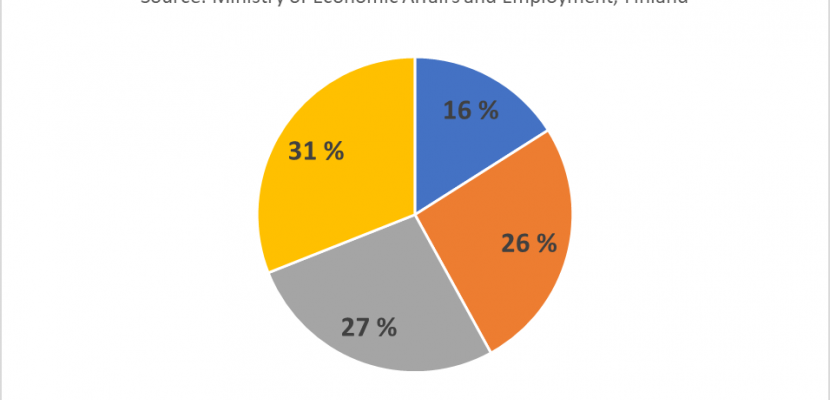Image

Energy Aid, Finland
Published on 13 June 2021

Finland
This is the good practice's implementation level. It can be national, regional or local.
About this good practice
The key aim of the Energy Aid grant is to promote the development of innovative solutions for replacing the energy system with a low-carbon alternative. The Aid can be granted for climate and environment friendly investigation and investment projects that increase energy efficiency and use of renewable energy.
The specific objectives are growth of renewable energy use, energy savings through energy efficiency, adaptation of new technology, and support for implementation of voluntary energy audits
Grant levels for conventional technology: investigations and energy audits 40-50%, investments 15-25%; and for new technology: investments in renewable energy sources and energy efficiency 20-24%.
Eligible applicants cover companies of all sizes, inc. SMEs. The Ministry of Economic Affairs and Employment (MEAE) provides funds in its annual budgets (about 30 MEUR per year). Business Finland is the grant management organisation with a specialised Energy Aid Team.
Across the EU, there are different instruments to support energy efficiency actions of SMEs, but many of them are implemented in projects with a limited timeframe. An example of a permanent structure is the German Energy Efficiency Fund, a wider programme with different policy measures, funding schemes, and educational activities. The Finnish Energy Aid stands out due to its clear structure, methodology of expert and information support, and Online Service to manage the applications and projects.
The specific objectives are growth of renewable energy use, energy savings through energy efficiency, adaptation of new technology, and support for implementation of voluntary energy audits
Grant levels for conventional technology: investigations and energy audits 40-50%, investments 15-25%; and for new technology: investments in renewable energy sources and energy efficiency 20-24%.
Eligible applicants cover companies of all sizes, inc. SMEs. The Ministry of Economic Affairs and Employment (MEAE) provides funds in its annual budgets (about 30 MEUR per year). Business Finland is the grant management organisation with a specialised Energy Aid Team.
Across the EU, there are different instruments to support energy efficiency actions of SMEs, but many of them are implemented in projects with a limited timeframe. An example of a permanent structure is the German Energy Efficiency Fund, a wider programme with different policy measures, funding schemes, and educational activities. The Finnish Energy Aid stands out due to its clear structure, methodology of expert and information support, and Online Service to manage the applications and projects.
Expert opinion
Businesses, especially SMEs, often struggle to make low-carbon interventions in their buildings and processes because of low-awareness, lack of skills or lack of financial resources. As such, many countries and regions have established instruments to support SMEs through energy audits and new installations. The Energy Aid scheme here is interesting for its permanent structure (indeed, many such support schemes are short-term, with a limited global budget, often under ERDF OPs), which can be taken as a good example. It takes significant time and effort to build up awareness and trust in new, short-term schemes – long-term schemes can benefit from better awareness and therefore also have better ling-0term impact.
Works at
Interreg Europe Policy Learning Platform
Resources needed
Annual budget e.g. from a responsible ministry; Team for grant advisory and management (processing of applications, project reports, payment claims); Web page with instructions, checklists, and templates; Communication resources; Online service for applications and reporting (not compuls.
Evidence of success
Energy Aid counts for 18% of Finland’s public funds for energy investments. Of the total € 393 million granted so far, approx. 270 million was directed to renewables and 123 million to energy efficiency. The companies benefit e.g. from increased energy efficiency, lower energy costs, smaller carbon footprint, and improved organisational image. An example of Aid impact (2017): growth of renewably energy production amounted 353 GWh, reduction of CO2 147 000 tonnes, creation of 40 permanent jobs.
Potential for learning or transfer
Policy level:
• Public intervention and scheme with no foreseen ending
• Concrete support grant for SMEs with direct focus on energy efficiency
• Supports both investigations and investments
Practical organising:
• Recruitment of new experts or reorganising the existing personnel (part-time).
• Support for applicants (approach and methodology): advisory, instructions, checklists, templates and other models
• Concrete tools for investigations and justifying the investment: energy audits (comprehensive reports on energy consumption and saving potential), and carbon footprint calculations for products, services, and organisations
• Online service (applications + managing the projects’ lifecycle). The costs vary depending on the scale (available funding, geographic scope etc.). Online service might be integrated with an existing one or implemented on longer timescale.
• Adaptation of key criteria: estimated energy savings, reduction of carbon dioxide emissions, and payback time
• Public intervention and scheme with no foreseen ending
• Concrete support grant for SMEs with direct focus on energy efficiency
• Supports both investigations and investments
Practical organising:
• Recruitment of new experts or reorganising the existing personnel (part-time).
• Support for applicants (approach and methodology): advisory, instructions, checklists, templates and other models
• Concrete tools for investigations and justifying the investment: energy audits (comprehensive reports on energy consumption and saving potential), and carbon footprint calculations for products, services, and organisations
• Online service (applications + managing the projects’ lifecycle). The costs vary depending on the scale (available funding, geographic scope etc.). Online service might be integrated with an existing one or implemented on longer timescale.
• Adaptation of key criteria: estimated energy savings, reduction of carbon dioxide emissions, and payback time
Further information
Website
Good practice owner
You can contact the good practice owner below for more detailed information.
Organisation
Business Finland

Finland
Etelä-Suomi
Contact
Senior Adviser
